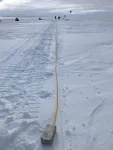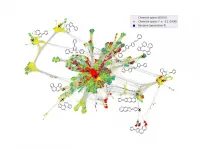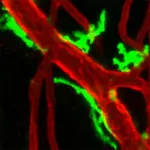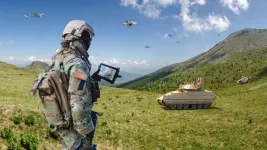INFORMATION:
Fiber optic cable monitors microseismicity in Antarctica
2021-04-23
(Press-News.org) At the Seismological Society of America's 2021 Annual Meeting, researchers shared how they are using fiber optic cable to detect the small earthquakes that occur in ice in Antarctica.
The results could be used to better understand the movement and deformation of the ice under changing climate conditions, as well as improve future monitoring of carbon capture and storage projects, said Anna Stork, a geophysicist at Silixa Ltd.
Stork discussed how she and her colleagues are refining their methods of distributed acoustic sensing, or DAS, for microseismicity--earthquakes too small to be felt. DAS works by using the tiny internal flaws within an optical fiber as thousands of seismic sensors. An instrument at one end sends laser pulses down the cable and measures the "echo" of each pulse as it is reflected off the fiber's internal flaws.
When the fiber is disturbed by earthquakes or icequakes, there are changes in the size, frequency and phase of laser light scattered back to the DAS receiver that can be used characterize the seismic event.
Michael Kendall of the University of Oxford said the Antarctic research demonstrates how DAS can be used to monitor underground carbon capture and storage at other sites in the world. For instance, the layout of the Antarctic network offers a good example for how a similar network could be configured to best detect microseismicity that could be triggered by carbon storage.
"Our work also demonstrates a method of using DAS fiber arrays to investigate microseismic earthquake source mechanisms in more detail than conventional geophones," said Tom Hudson of the University of Oxford. "If we can analyze the source mechanism--how an earthquake fails or fractures--then we may be able to attribute the earthquake to the movement of fluids like carbon dioxide in a reservoir."
The Antarctic microseismic icequakes recorded by DAS "are approximately magnitude -1, corresponding to approximately the size of a book falling off a table," Hudson explained, "so they are very small earthquakes."
The study by Hudson and colleagues is the first to use DAS to look at icequakes in Antarctica. The fiber optic cable was deployed in a linear and triangular configuration on the ice surface at the Rutford Ice Stream.
Kendall said there are a number of challenges to using fiber optic sensors in the harsh Antarctica environment. The equipment had to travel in pieces by boat and several planes to the study site. The researchers had to bury the fiber to reduce wind noise contaminating the seismic signal, as well as remove the signal of a generator that powered the DAS instrument.
"We housed the instrument in a mountaineering tent, which basically served as a tiny office," Stork explained. "Keeping temperatures within the recommended operating limits was a challenge. The radiative heating from the sun warned the tent to well in the 30s [degrees Celsius], even though it was -10 degrees Celsius outside."
The researchers share their analyses of icequake data with climatologists and other researchers studying the slip of glaciers and other ice movements in Antarctica, Kendall said.
"Hopefully in the future we will interact more with scientists drilling ice cores too, as they use fiber as distributed temperature sensors, but these fibers that they put down boreholes could also be used for seismic studies like ours," he noted.
ELSE PRESS RELEASES FROM THIS DATE:
DeepShake uses machine learning to rapidly estimate earthquake shaking intensity
2021-04-23
A deep spatiotemporal neural network trained on more than 36,000 earthquakes offers a new way of quickly predicting ground shaking intensity once an earthquake is underway, researchers report at the Seismological Society of America (SSA)'s 2021 Annual Meeting.
DeepShake analyzes seismic signals in real time and issues advanced warning of strong shaking based on the characteristics of the earliest detected waves from an earthquake.
DeepShake was developed by Daniel J. Wu, Avoy Datta, Weiqiang Zhu and William Ellsworth at Stanford University.
The earthquake data used to train ...
Seismicity on Mars full of surprises, in first continuous year of data
2021-04-23
The SEIS seismometer package from the Mars InSight lander has collected its first continuous Martian year of data, revealing some surprises among the more than 500 marsquakes detected so far.
At the Seismological Society of America (SSA)'s 2021 Annual Meeting, Savas Ceylan of ETH Zürich discussed some of the findings from The Marsquake Service, the part of the InSight ground team that detects marsquakes and curates the planet's seismicity catalog.
Marsquakes differ from earthquakes in a number of ways, Ceylan explained. To begin with, they ...
Toward new solar cells with active learning
2021-04-23
How can I prepare myself for something I do not yet know? Scientists from the Fritz Haber Institute in Berlin and from the Technical University of Munich have addressed this almost philosophical question in the context of machine learning. Learning is no more than drawing on prior experience. In order to deal with a new situation, one needs to have dealt with roughly similar situations before. In machine learning, this correspondingly means that a learning algorithm needs to have been exposed to roughly similar data. But what can we do if there is a nearly infinite amount of possibilities so that it is simply impossible to generate data ...
Newly discovered immune cell function vital to healing
2021-04-23
Cardiovascular disease, the most common cause of death, is the result of oxygen deprivation as blood perfusion to affected tissue is prevented. To halt the development of the disease and to promote healing, re-establishment of blood flow is crucial. Researchers at Uppsala University have now discovered that one of the most common immune cells in the human body, macrophages, play an important role in re-establishing and controlling blood flow, something that can be used to develop new drugs.
The classic function of immune cells is to defend the body against attacks from microorganisms and tumour cells. Macrophages are immune cells specialised in killing and consuming microorganisms but they have ...
Travel paths of primates show how their minds work
2021-04-23
How primates get from A to B gives vital information about their cognitive evolution, say researchers in a new study looking at the travel paths of animals in the wild. Using data from 164 wild primate populations, the global survey examines the mental abilities that primates, including ourselves, use to know where and when to travel in the most efficient way.
A birds eye view
Co-author Miguel de Guinea, expert in Evolutionary Anthropology at Oxford Brookes University commented: "Imagine looking down on a huge outdoor market from high in the sky, perhaps from a drone hovering quietly above. The people below move in different ways. Some wander haphazardly among the stalls: they are learning what's available but are clearly not busy. Others take bee-line routes ...
Hubble captures giant star on the edge of destruction
2021-04-23
In celebration of the 31st anniversary of the launching of NASA's Hubble Space Telescope, astronomers aimed the renowned observatory at a brilliant "celebrity star," one of the brightest stars seen in our galaxy, surrounded by a glowing halo of gas and dust.
The price for the monster star's opulence is "living on the edge." The star, called AG Carinae, is waging a tug-of-war between gravity and radiation to avoid self-destruction.
The expanding shell of gas and dust that surrounds the star is about five light-years wide, which equals the distance from here to the nearest star beyond the Sun, Proxima Centauri.
The huge ...
New data could inform youth-focused pandemic messaging
2021-04-23
Now that teens and young adults across the country account for an increasing share of COVID-19 cases, and many have become eligible for vaccination, several recently published studies based on polls of this age group provide insights into the kinds of messaging that might work best for both preventing transmission and vaccine uptake.
Using data from text-message polls of people between the ages of 14 and 24 taken at several points in 2020, researchers from the University of Michigan find a clear theme: that most young people are taking COVID-19 seriously and trying to follow public health guidance, and that many of them they are motivated by the desire to protect ...
Army, ASU publish human-autonomy communication tips
2021-04-23
ABERDEEN PROVING GROUND, Md. -- Army and Arizona State University researchers identified a set of approaches to help scientists assess how well autonomous systems and humans communicate.
These approaches build on transformational scientific research efforts led by the Army's Robotics Collaborative Technology Alliance, which evolved the state of robots from tools to teammates and laid the foundation for much of the service's existing research into how humans and robots can work together effectively.
As ideas for autonomous systems evolve, and the possibilities ...
Critical understanding of why and how solid-state batteries
2021-04-23
Researchers from the Faraday Institution's SOLBAT project have made a significant step in understanding how and why solid-state batteries (SSBs) fail. A paper, published in Nature Materials on 22 April, provides answers to one important piece of the scientific puzzle.
To make step changes in electric vehicle (EV) battery range and safety at a lower cost, new battery chemistries that are "beyond lithium ion" must be developed. SSBs are one such promising technology, but mass market adoption has been held back by several key technical challenges that cause the battery to fail when charged and discharged.
SSBs can short circuit after repeating charging and discharging. One well-recognised cause of battery failure is the growth of dendrites, branching networks of lithium that ...
First description of a new octopus species without using a scalpel
2021-04-23
An evolutionary biologist from the University of Bonn brought a new octopus species to light from depths of more than 4,000 meters in the North Pacific Ocean. The sensational discovery made waves in the media a few years ago. Researchers in Bonn have now published the species description and named the animal "Emperor dumbo" (Grimpoteuthis imperator). Just as unusual as the organism is the researchers' approach: in order to describe the new species, they did not dissect the rare creature, but instead used non-destructive imaging techniques. The results have now been published in the prestigious journal BMC Biology.
In the summer of 2016, Dr. Alexander ...






